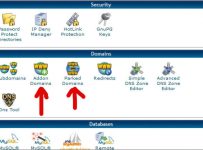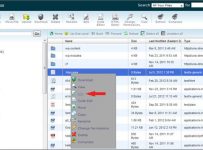-
cPanel Tutorial: Working with Remote MySQL Database Connection

Usually a database (Ex, MySQL Database) and a database management application software (Ex. phpMyAdmin) both reside on the same system/server; hence establishing a connection between them does not involve much of a hassle. However, if someone needs to access the database (hosted on the server) using a software installed on a personal computer or any…
-
cPanel Tutorial – Creating Addon and Parked Domain

Addon Domain at a Glance cPanel’s Addon Domain feature allows a webmaster to control multiple domains from a single hosting panel. An addon domain is a fully functional, independant domain that can be hosted within your existing cPanel account. Addon domain functionality provides you an option to host and manage more than one domain from a single control…
-
cPanel Tutorial: Configuring Google Webmail (Gmail) to Access Domain Mailbox

Wouldn’t it be great if your domain mailbox would have all the functionalities of Gmail and you could access your domain email through an easy-to-remember URL like http://mail.yourdomain.com? Gmail is arguably regarded as the most trusted e-mail client as far as security and functionality are concerned; and Gmail’s user-friendly interface has made it the most preferred mode…
-
cPanel Tutorial: Verifying Domain Ownership for Activating Google Apps for Work

Note: Google Apps for Work is now known as G Suite. Most of the features, and the process for domain ownership verification, however remains the same. The very first step to activate Google Apps Service on your website is to verify your domain ownership. To put it from Google’s perspective, in order to protect your…
-
Plesk Tutorial: How to Recover Forgotten Administrator Password

Have you ever forgotten the administrator password for logging in to your Plesk Panel hosting interface? Well, it is one of the most common issues that we all have faced at some point of time, irrespective of our technical expertise level. You will be surprised to know that according to Google Keyword Trends, “Recover Admin Password” is the…
-
Plesk Panel Tutorial – Creating a Password Protected Directory

Directories or sub-directories inside your publicly available content (public.html folder) on your website can be prevented from being accessed by general visitors by using a password as the shield. There are several ways in which it can be achieved. The most common of all is to use the inbuilt feature that comes with select control…
-
cPanel Tutorial – How to Manually Edit .htaccess File

.htaccess file is a directory-level text file, that allows for decentralized management of Apache web server configuration without direct root access to the physical server. .htaccess stands for ‘Hypertext Access’. This file can be modified to override the server’s global configuration settings. It is often used to set up URL rewrite rules and/or to specify security…
-
cPanel Tutorial: Creating and Restoring Backups

People often forget to make backup of their data on web-hosting accounts. The only time most people remember backup option is when their web host turn bad or their website is compromised or they have to move to a new web host. To make sure you don’t face the same fate, you should make sure…
-
cPanel Tutorial: How to Configure URL Redirection?

What Is URL Redirection? URL Redirection, also known as URL Forwarding, allows webmasters to divert their visitors to another web address and display the content of that page. A URL Redirection can also be conceptualized as a technique, which, can make a web page to be available under more than one web address. Using URL Redirection…
-
cPanel Tutorial: Configuring Hotlink Protection to Prevent Bandwidth Theft

What Is a Hotlink? Hotlinking, also referred to as Inline Linking or Leeching, is an unethical concept of creating a link to point to an existing web object (most often an image/video file) residing in a particular website and display its exact replica on another website utilizing the former’s resources. Creating hotlink amounts to bandwidth…
-
WHM Tutorial – 8 Easy Tweaks to Optimize VPS Performance

One common cause of concern for most of the VPS Hosting users is the incremental trend of CPU, bandwidth and memory consumption. Web hosting resources – like Bandwidth, Memory or CPU – come with a certain price tag and it is of utmost importance to limit the usage of resources in order to curb the ever increasing cost of running…
-
cPanel Tutorial: Using phpMyAdmin

In an earlier cPanel tutorial, we discussed Creating a MYSQL Database through cPanel. Once you have created a database, the next step is to manage this database. Either you need to create a table or modify an existent table, you can do this all through phpMyAdmin. Step 1: Locating phpMyAdmin In your cPanel account, you can find…
